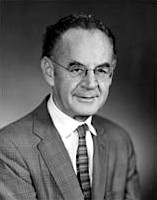Biography:Albert Rose (physicist)
Albert Rose | |
|---|---|
 | |
| Born | 30 March 1910 New York City , New York |
| Died | 26 July 1990 (aged 80) Princeton, New Jersey |
| Known for | Rose criterion, Detective quantum efficiency |
| Awards | IEEE Edison Medal (1979) |
Albert Rose (30 March 1910 – 26 July 1990) was an American physicist, who made major contributions to TV video camera tubes such as the orthicon, image orthicon, and vidicon.[1][2]
Biography
He received an A.B. degree and a Ph.D. degree in Physics from Cornell University in 1931 and 1935, respectively. He joined RCA, where was active in the development of TV camera tubes.
Rose was an expert on photoconductivity. He wrote a book "Concepts in photoconductivity and allied problems", which was published by John Wiley & Sons, New York in 1963.
He also did research on the visibility of objects in a noisy signal, such as from TV tubes. He found that humans could distinguish small objects in noisy images at near 100% accuracy if the object brightness differed from the background by at least 5 times the noise standard deviation; this signal-to-noise relationship is known as the Rose criterion.[3][4]
Rose also originated the concept of detective quantum efficiency, today widely used in optical and X-ray imaging.
He died in 1990.[1]
US patents
- U.S. Patent 4,139,796 Photoconductor for imaging devices
- U.S. Patent 3,952,222 Pickup tube target
- U.S. Patent 3,934,180 Method of reproducing an electrostatic charge pattern in intensified form
Honors and awards
- Member, National Academy of Engineering in 1975[5][6]
- IEEE (Institute of Electrical and Electronic Engineers) Edison Medal in 1979
- IEEE Morris N. Liebmann Award
- SMPTE (Society of Motion Picture and Television Engineers) David Sarnoff Gold Medal Award
- Fellow, IEEE
- Fellow, American Physical Society
References
- ↑ 1.0 1.1 "Albert Rose, a Research Scientist Known for TV Tube, Dies at 80.". The New York Times. "Albert Rose, a research scientist whose work in converting optical images to electrical signals led to the development of the modern television picture tube, died on Thursday at the Princeton Medical Center in New Jersey. He was 80 years old and lived in Princeton. He died of lung cancer, a family member said. He is survived by his wife, Lillian; a son, Mark, of Mendham, N.J.; a daughter, Jane Speiser, who lives in Italy; a brother, Martin Rosenblum of Middletown, N.Y., and two grandchildren."
- ↑ Johnson, Walter; Weimer, Paul K.; Williams, Richard (December 1991). "Obituary: Albert Rose". Physics Today 44 (12): 98. doi:10.1063/1.2810377. Bibcode: 1991PhT....44l..98J. http://www.physicstoday.org/resource/1/phtoad/v44/i12/p98_s1?bypassSSO=1.
- ↑ Rose, Albert (1973). Vision - Human and Electronic. Plenum Press. p. 10. ISBN 9780306307324. https://books.google.com/books/about/Vision_Human_and_Electronic.html?id=s0GjM_rY95kC. "[...] to reduce the number of false alarms to below unity, we will need [...] a signal whose amplitude is 4-5 times larger than the rms noise."
- ↑ Debbie Stokes (2008). Principles and Practice of Variable Pressure/Environmental Scanning Electron Microscopy (VP-ESEM). John Wiley & Sons. p. 55. ISBN 9780470065402. https://books.google.com/books?id=TgYJv5BHIQ0C&pg=PA55.
- ↑ "Dr. Albert Rose". https://www.nae.edu/MembersSection/MemberDirectory/28655.aspx.
- ↑ "Albert Rose - Memorial Tributes: Volume 6 - The National Academies Press". doi:10.17226/2231. https://www.nap.edu/read/2231/chapter/40.
External links
- IEEE Global History Network bio with photo

